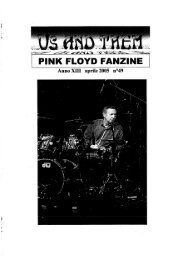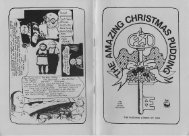Create successful ePaper yourself
Turn your PDF publications into a flip-book with our unique Google optimized e-Paper software.
One has also issued a CD titled ‘A CD Full of<br />
Secrets’. It is uncertain if the CD was sent to radio<br />
stations only. This CD is not really a radio show, it is<br />
a collection of rare Pink Floyd songs and was<br />
released in two versions. As a standard issue in a<br />
jewel case and as a limited edition in a white<br />
lacquered wooden box.<br />
Most of the radio shows in this discography are listed<br />
<strong>com</strong>pany by <strong>com</strong>pany. Only two renowned lines of radio<br />
shows are listed together whilst the CDs have different<br />
publishers:<br />
In The Studio: Album Network, SFX, Winstar Radio<br />
Services, Excelsior Radio Networks.<br />
Up Close: MCA, Media America Radio, Jones Radio<br />
Network.<br />
Some record labels (for example EMI and Capitol) have<br />
also issued CDRs with advertisements to promote new<br />
albums. These CDs with very short content (sometimes of<br />
very few seconds only) are not a typical rado shows but<br />
they were produced especially for radio broadcast. You<br />
can also find these CDs listed here.<br />
Radio CDs are very valuable to some collectors. Due to<br />
limitation of these edition they are rarer than most of the<br />
promotional issues and have reached very high prices on<br />
the collector’s market.<br />
The presentation of the shows with Pink Floyd or band<br />
members solely includes the picture of the CD and<br />
artwork. But the pictures of the individual covers or generic<br />
sleeves are only included if the CD was issued with<br />
artwork - in many cases the radio shows were issued in<br />
neutral white sleeves or clear plastic wallets. In these<br />
cases you can see the image of the CD only.<br />
In some cases you can also find images of original cue<br />
sheets. While most of the radio shows were ac<strong>com</strong>panied<br />
by the cue sheets, it is very hard to find these papers<br />
today.<br />
The shows with various artists featuring Pink Floyd or band<br />
members are only listed, without illustrations.<br />
PIRATES and COUNTERFEITS<br />
One can quite often hear of pirate issues. But there is a<br />
small difference within this concept. International<br />
Federation of the Phonographic Industry (IFPI) points out a<br />
difference between pirate and counterfeited material.<br />
Pirate issues are described by IFPI as an unauthorised<br />
duplication of music from legitimate recordings without<br />
permission from the owner of the copyrights for<br />
<strong>com</strong>mercial use. The quality of artwork and pressing will<br />
therefore be inferior. More important - the artwork differs<br />
from the original.<br />
Examples of pirate issues<br />
Counterfeit issues are a <strong>com</strong>pletely unauthorised copy of<br />
an original CD as well as the imitation of the artwork,<br />
trademarks and logos.<br />
Examples of counterfeits with clear trays.<br />
All of them have only 8 page booklets.<br />
An alarming number of fakes and counterfeits of official<br />
Pink Floyd albums circulates on the market. Mainly the<br />
counterfeiters attempt to copy the remastered editions, but<br />
they also release certain “special” or “limited edition” CDs.<br />
But the counterfeits are easily revealed - even for<br />
beginners. Consulting this discography helps in many<br />
cases: All official artwork versions are listed in here.<br />
Further on here are some rules which help distinguishing<br />
the original from the fake:<br />
- Pink Floyd neither released HDCDs nor DVD-Audio.<br />
- No edition was released with a subtitle like “special”<br />
or “limited” which was directly printed on the cover.<br />
Exception: Sony’s SBM CD Wish You Were Here in a<br />
longbox.<br />
- No album contains bonus tracks on the same CD -<br />
the exception is The Final Cut (2004 re-edition with<br />
the song ‘When the Tigers Broke Free’).<br />
- The label design for the CDs of the Shine On edition<br />
was unique and these labels did not appear on any<br />
other editions.<br />
- Except editions listed in the Overview ‘Cardboard<br />
Sleeve LP Replica’ no other mini LP editions were<br />
ever released<br />
- No edition was released with a bonus DVD. The<br />
exception is the UK release of London 1966/1967 on<br />
Snapper Music and the 2010 reedition of Knebworth<br />
The Album. Both editions contain DVD + CD(s) and<br />
were issued in an 13,5x18,5 cm digipaks.<br />
- Almost all jewel case editions of the albums (original<br />
and remastered editions) were sold with black<br />
(Europe, USA) or partially with bright (Japan) trays<br />
and single-sided printings on the back cover. The<br />
exception are:<br />
In London 1966*1967 (edition with bonus CDROM<br />
and Pucka release)<br />
Wish You Were Here Master Sound (edition in<br />
slipcase)<br />
The Wall Live (standard edition)<br />
Pulse (2006 reedition in a double slim case)<br />
Echoes<br />
The Dark Side of the Moon (SACD)<br />
Knebworth (reedition)<br />
Zabriskie Point (2CD reissue in slimcase)<br />
40 th anniversary edition of The Piper at the Gates of<br />
Dawn (2CD issue)<br />
London 1966/1967 (in super jewel case)<br />
These editions have clear trays and double-sided<br />
printings on the rear artwork.<br />
- Remastered editions contain booklets with at least<br />
12 pages (The Final Cut) but more <strong>com</strong>monly with<br />
16-24 pages.<br />
Distinguishing original solo albums from counterfeits is a<br />
bit more <strong>com</strong>plicated. There are no clear rules which allow<br />
a clear distinction and some of the fakes hardly differ from<br />
the original. But <strong>com</strong>pared to the Pink Floyd albums there<br />
are fewer counterfeits circulating.<br />
The so-called SID Code, which was introduced by the IFPI<br />
and Philips, can be an other point of distinguishing an<br />
original pressing from a pirate issue. Genuine discs usually<br />
have a SID Code (the letters ‘IFPI’ and a four character






